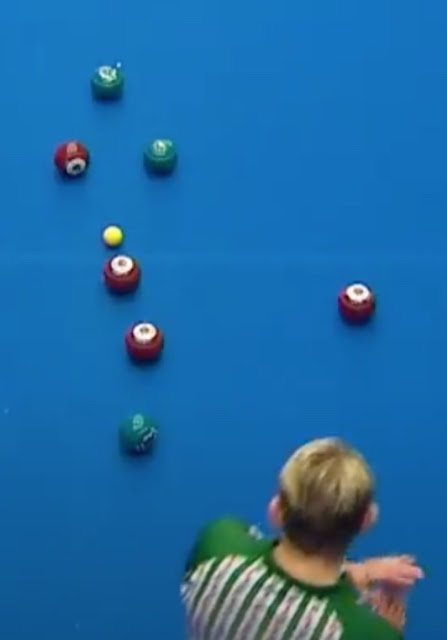The author’s delivery is more like that of David Gourlay than any other professional indoor lawn bowler. It is interesting that although David is perhaps the best overall athlete among the top bowlers, his delivery is physically undemanding.
Grip
David uses something between the claw grip and what is called the gyrostatic grip. The gyrostatic grip was designed to allow the hand and forearm to remain in its normal position, without needing to turn the hand palm up, as is the case with other grips. The palm and fingers are located on the side of the bowl with the thumb on top. Put simply it looks like the bowler is palming the bowl from the side.
According to Len Hyde, a coach from New South Wales Australia, it is no longer taught, at least in Zone 9 of Australia. Neither can I can find any online references to the grip.
In David’s adaption, his thumb rests on the grip but is more forward than most people’s. His thumb is almost above the rotational axis of the bowl. His index finger runs down the side of the bowl with the fingertip in the grip ring. His remaining three fingers seem to be together, all on the running surface, but with the long middle finger on the center of the running surface.
Ready Position
Gourlay adopts the Shooters’ stance to the extent that the toes of his anchor footare slightly turned in towards his aim line. His stepping foot is a shoe length forward of it. Most characteristically- his non-bowling hand is already on his knee before his action begins. His arm when ready is about 30 degrees from vertical and the bowl is at a height just below his knee.
Delivery
Because his grip already turns his palm in towards his side, no Bryant twist is needed in David’s backswing. The backswing is short and tight enough to his body that he wouldn't actually need to bend his anchor leg in behind his advancing leg, although he does.
When he releases his bowl his index finger remains outstretched but his other fingers curl up behind the bowl as if to give it a flick. This is made clear in the close-up picture of his hand just after letting go of the bowl. This seems a consistent attribute of his delivery.
Because of his grip, the bowl leaves his hand with some wobble. Gourlay seems to adjust for length by varying the length of his forward stepping. He follows through low and does not walk off the mat.
For some reason that I cannot even hypothesize about, he, more than other players, asks the marker to move because the rink boundary stripe is being obscured.
Follow-through
Walking off the mat is not part of David's delivery. His weight goes fully forward but his anchor foot remains on the mat until the bowl is well down the rink.























